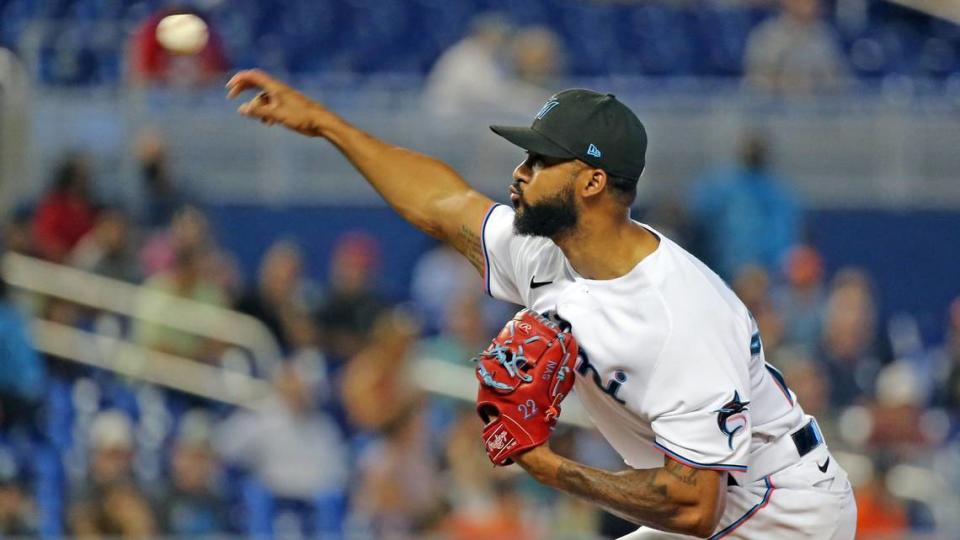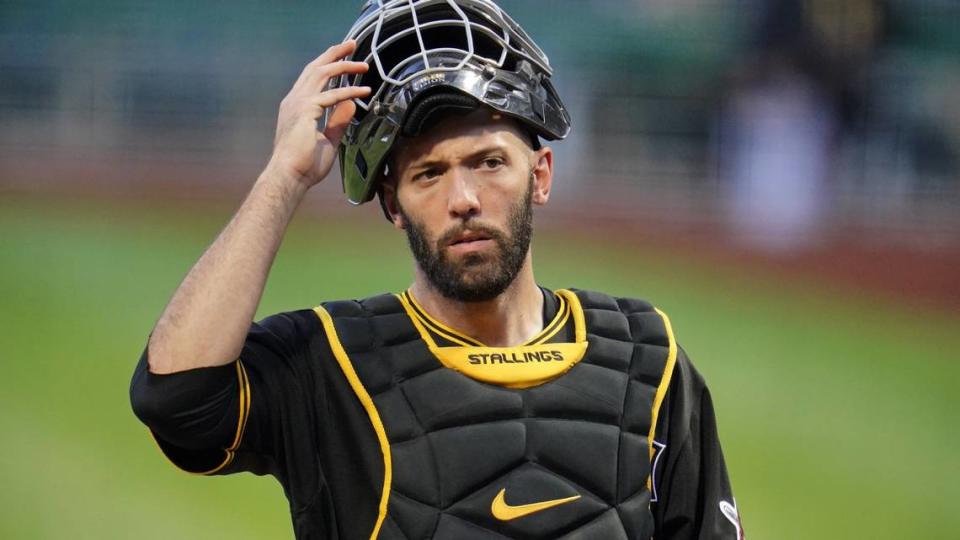Miami Marlins’ offseason moves were ‘years in the making.’ Why now was the time
As the Miami Marlins set out to begin this offseason, a list full of needs in hand, general manager Kim Ng looked at the process like a puzzle.
Each piece that they have at their disposal, each move that they make or don’t make, each step forward or backward, will impact what comes next. The interlocking nature of individual moves, moves that will help the club both in the immediate and the future, can’t be discarded.
That’s how the Marlins got to where they are now.
All three players the Marlins have acquired so far — Gold Glove catcher Jacob Stallings and one-time All-Star infielder Joey Wendle via trade, one-time All-Star Avisail Garcia as a free agent — are slated to be with the team for multiple years. Wendle has two more years of team control. Stallings has three. Garcia signed a four-year deal with a club option for a fifth year.
They also gave Sandy Alcantara a five-year contract extension with a sixth-year option, which has him set to be with Miami potentially through the 2027 season.
“This is years in the making,” Marlins CEO Derek Jeter said Wednesday, hours before MLB’s collective bargaining agreement expired and the league imposed a lockout of its players. “We’re looking ahead in the future.”
That was the thought process since Jeter and Bruce Sherman took over the club a little more than four years ago. Build the organization up to the point where they have a roster they feel can compete and then add those final pieces externally to complete the roster.
It took four seasons to get there — and they still might not fully be there yet — but the current state of the team and the additions brought in show the club’s direction.

It starts on the mound
Starting pitching has been the Marlins’ emphasis since the start of the rebuild. It’s one reason they prioritized extending Alcantara and have had discussions with him and his representatives since July to get the deal done.
The deal — five years and $56 million with a $21 million club option for the sixth year — is the largest given to an MLB pitcher who had yet to reach arbitration.
“In terms of building our foundation,” Ng said, “Sandy possesses all the things that we look for in players between talent performance, leadership in the clubhouse, dedication, work ethic, and I think his singular focus in bringing himself — all of himself — to the ballpark every single day and imparting his wisdom, his knowledge and really setting an example for the rest of our club.”
But this goes beyond Alcantara. Consider the rest of the Marlins’ rotation possibilities:
▪ Trevor Rogers, the runner-up for National League Rookie of the Year, has five more years of control.
▪ Pablo Lopez, arguably the Marlins’ most consistent pitcher beyond Alcantara, is just entering arbitration and is under control for three more years.
▪ Jesus Luzardo, a project who the Marlins see potential in, is under control for four more years.
▪ Prospects Sixto Sanchez and Edward Cabrera, who have ace potential if they can stay healthy, are both under control for five more years.
And that doesn’t include 2020 first-round pick Max Meyer, Elieser Hernandez, Jake Eder or the pitching depth they have in their older prospects (Braxton Garrett, Jordan Holloway, Nick Neidert and Cody Poteet among them).
The Marlins know how expensive quality starting pitching can be. Just look at some of the signings ahead of the lockout, even beyond the six-figure deals expected from Max Scherzer and Robbie Ray.
Kevin Gausman signed with the Blue Jays for five years and $110 million. Noah Syndergaard has a one-year, $21 million deal with the Angels. Eduardo Rodriguez signed with the Tigers for five years and $77 million.
Even Andrew Heaney signed a one-year, $8.5 million deal with the Dodgers.
Having quality pitching under team control is a luxury.
That’s why, Ng said, teams will have to offer a player or players who are “elite and impactful either for today or for the future” if the Marlins were to consider trading any of their established starting pitchers or top prospects.

Strong pitching needs a good catcher
This is where Stallings enters the puzzle. The catcher position was one the Marlins’ biggest liabilities when Jorge Alfaro never panned out to be the starter they hoped he would be after acquiring him from the Philadelphia Phillies as part of the J.T. Realmuto trade.
They tried different — and younger — options during the final two months last season in Alex Jackson, Payton Henry and Nick Fortes. None stepped up enough to cement himself as a starter.
Stallings provides the defensive acumen and the game-calling savvy to be the needed complement to Miami’s potential-filled starting pitching.
He has shown he has the capability to do that.
Jacob Stallings never thought he would be the focus of a trade. Then the Marlins called
His 28 defensive runs saved since he became a full-time starting catcher in 2020 leads the position, according to FanGraphs, and his framing rate according to the site is the second best in that span behind only the Milwaukee Brewers’ Omar Navarez. He was the only catcher last season with at least 500 innings behind the plate to not have a passed ball.
“When I talked to Kim and [manager] Don [Mattingly], that was the main thing that they brought up — just somebody that can help their pitching staff and that’s what they really want and value and I’m hopeful I can I can do that,” Stallings said. “I don’t know how much help these guys need. They’re all pretty good already, but anything I can do to help them and help the team, I’m gonna do everything I can.”

It also needs offense
Miami’s goal this offseason was to add “multiple bats,” as Ng put it in October. Considering how their offense fared in 2021 — second to last in runs scored, third to last in home runs, and tied for third to last in batting average, among a slew of daunting statistics — this had to be the priority.
Enter Garcia and Wendle.
Garcia is a middle-of-the-order hitter, a career .270 hitter who hit a career-high 29 home runs last season. He’s naturally a right fielder but has the potential to start in center field.
Wendle has a career .274 batting average and .328 on-base percentage and can play second base, shortstop and third base. His positional flexibility — in addition to that of Miguel Rojas (all four infield spots), Jazz Chisholm Jr. (second base and shortstop), Brian Anderson (third base and right field) and Jon Berti (everywhere except catcher and first base) — gives the Marlins a chance to potentially get creative with their lineups and find ways to get the best nine players on the field each night. The potential of a universal designated hitter can help on that front, too.
“You have to be greater than the sum of your parts,” Wendle said. “Selflessness goes a long way for that. ... We have to know our roles.”
Wendle and Garcia’s roles extend beyond the field.
Their additions — as well as Stallings and potentially more once a new collective bargaining agreement is in place and the free agency freeze is lifted — supplement the Marlins’ core of budding young players already on the roster.
That group includes the likes of Chisholm, first baseman Lewin Diaz, outfielders Jesus Sanchez and Bryan De La Cruz, and catchers Fortes, Henry and Jackson.
“I think you need to surround the young players and give them examples to look up to and those veteran players will show how it’s done every day,” Ng said. “One of the things about young players is that they tend to be a little bit streaky and I think that those veterans are definitely a calming, soothing presence.”
After slew of deals before looming lockout, Miami Marlins make it clear: ‘We’re not done’
Keeping the farm system intact
And while wins and losses at the MLB level is how the Marlins’ success will be gauged, keep in mind how they got to this point. They beefed up a barren farm system over the first four years through trades and drafts.
Even in acquiring Wendle and Stallings, Miami managed to do so without giving up any of its top-10 prospects according to MLB Pipeline.
For Stallings, they gave up starting pitcher Zach Thompson (a minor-league signing before the season), pitcher prospect Kyle Nicolas (No. 16 in Miami’s system at the time of the trade) and outfielder prospect Connor Scott (No. 23 in Miami’s system at the time of the trade). For Wendle, they sent outfielder prospect Kameron Misner (No. 22 in Miami’s system) to Tampa Bay.
Miami has seven pitchers in their system ranked higher than Nicolas was and four outfielders who were ahead of both Scott and Misner.
“There’s no question that in our farm system, we have certain areas of depth,” Ng said. “There could be a little bit more. We just had depth and so we can deal from the depth.”
